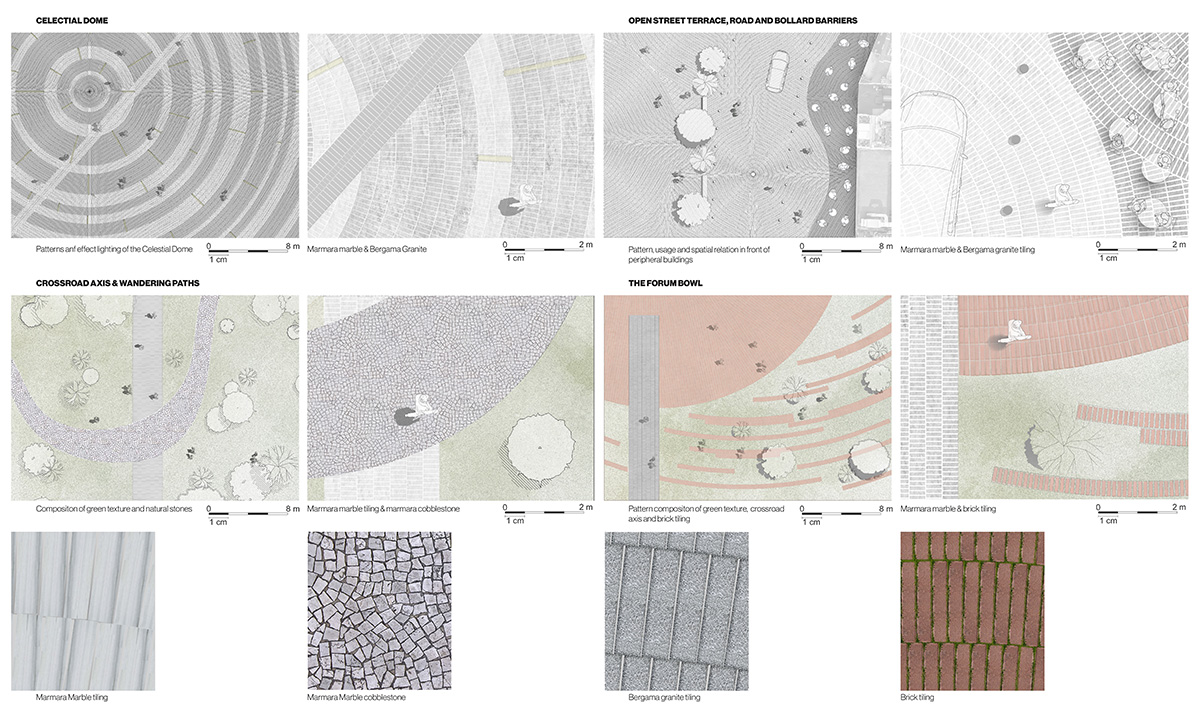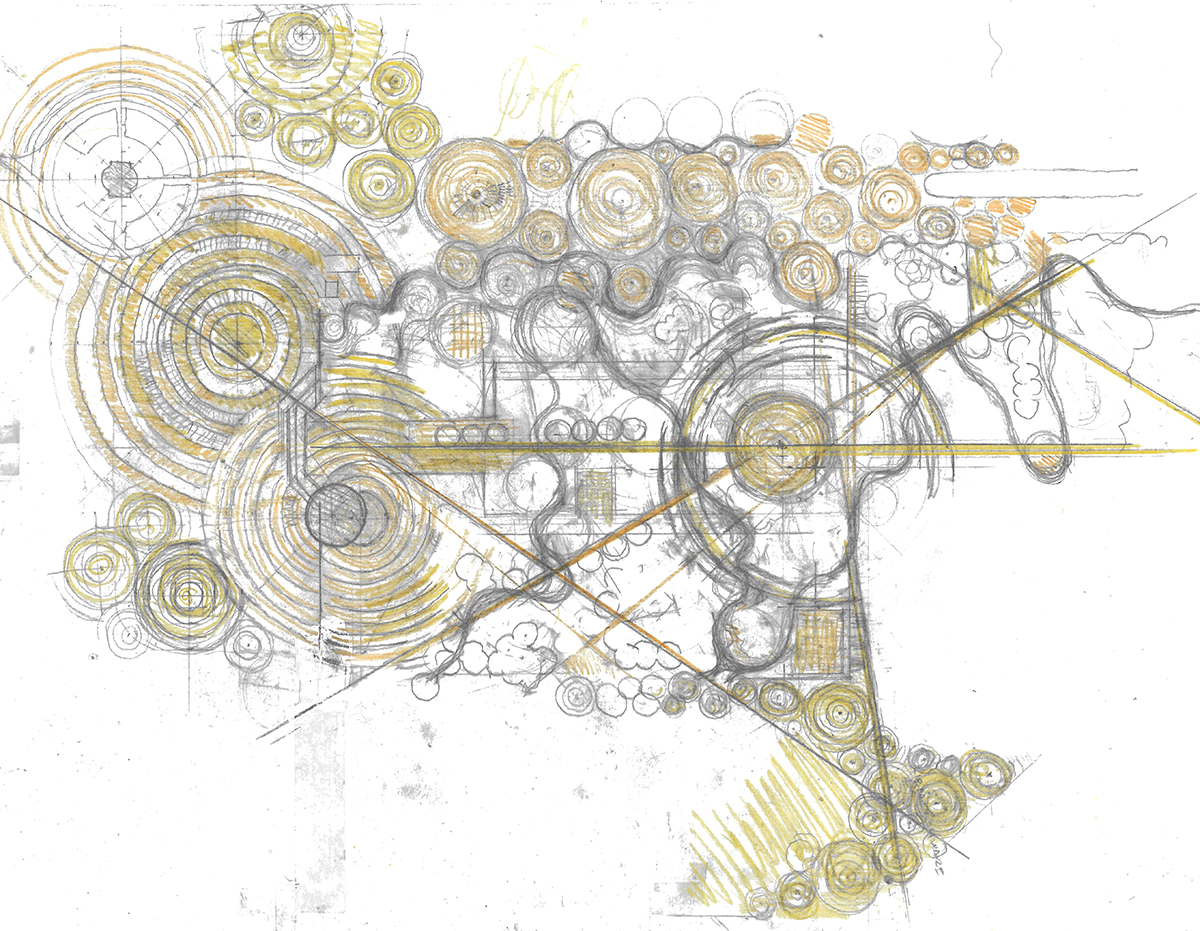
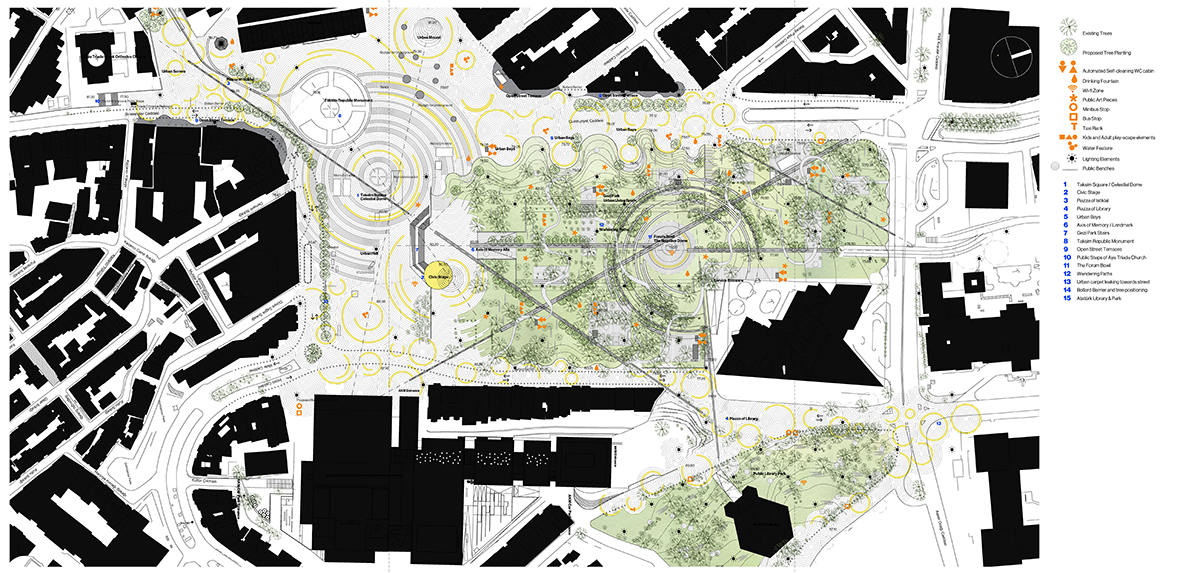
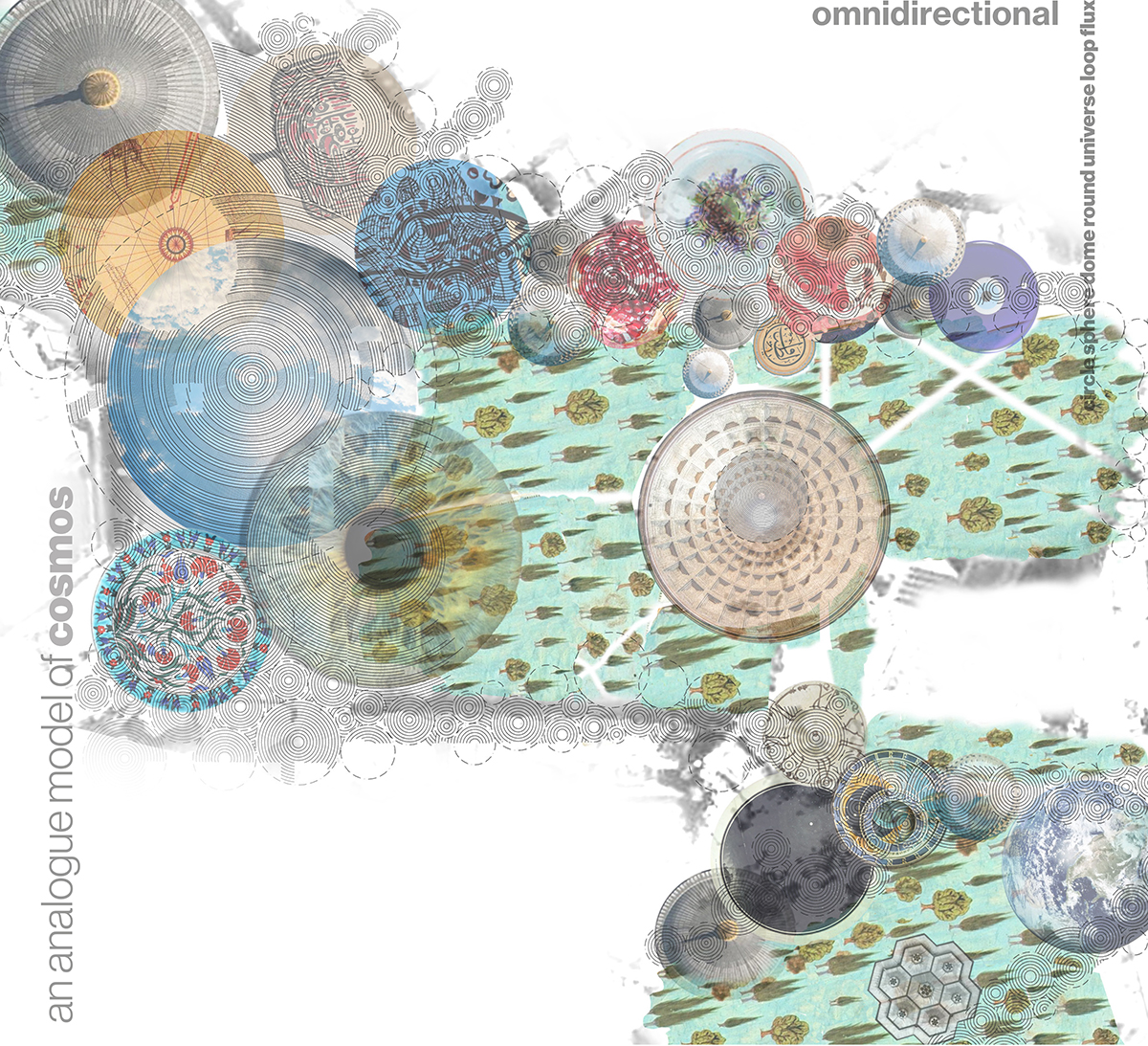
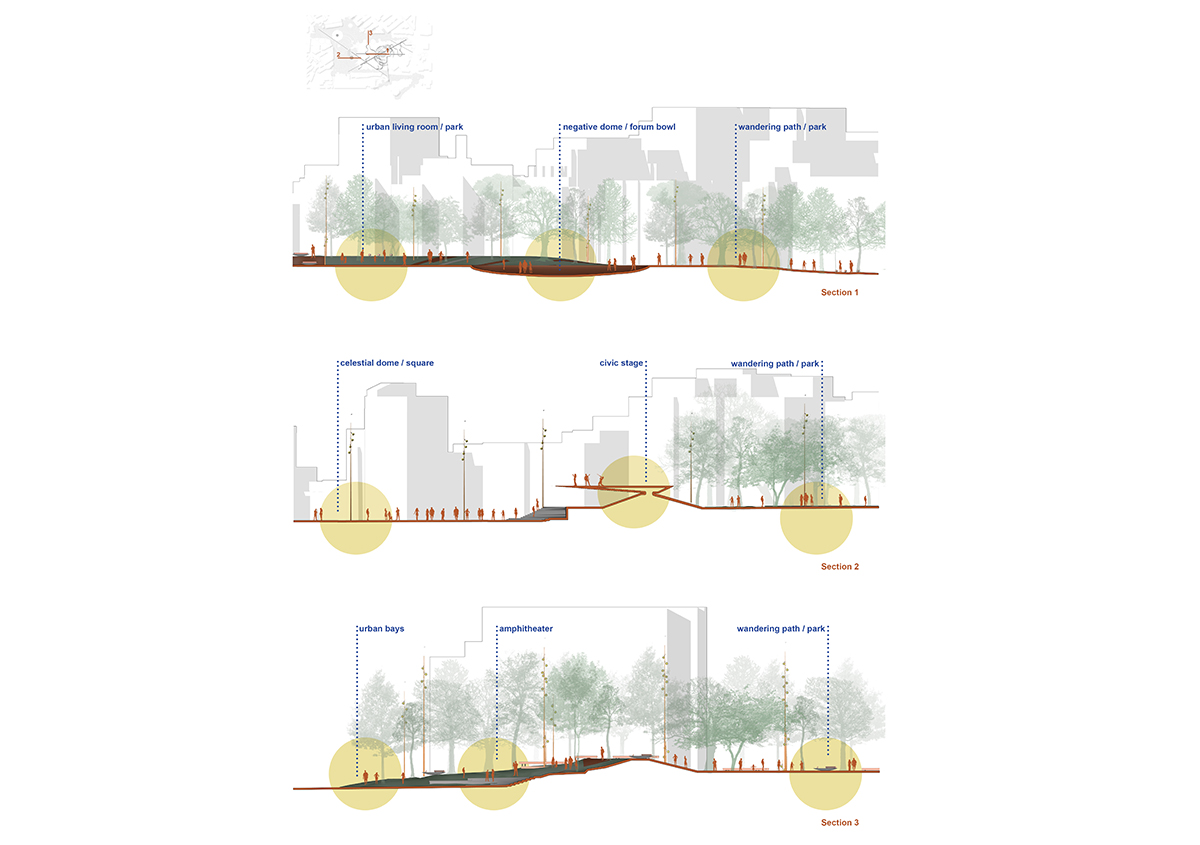
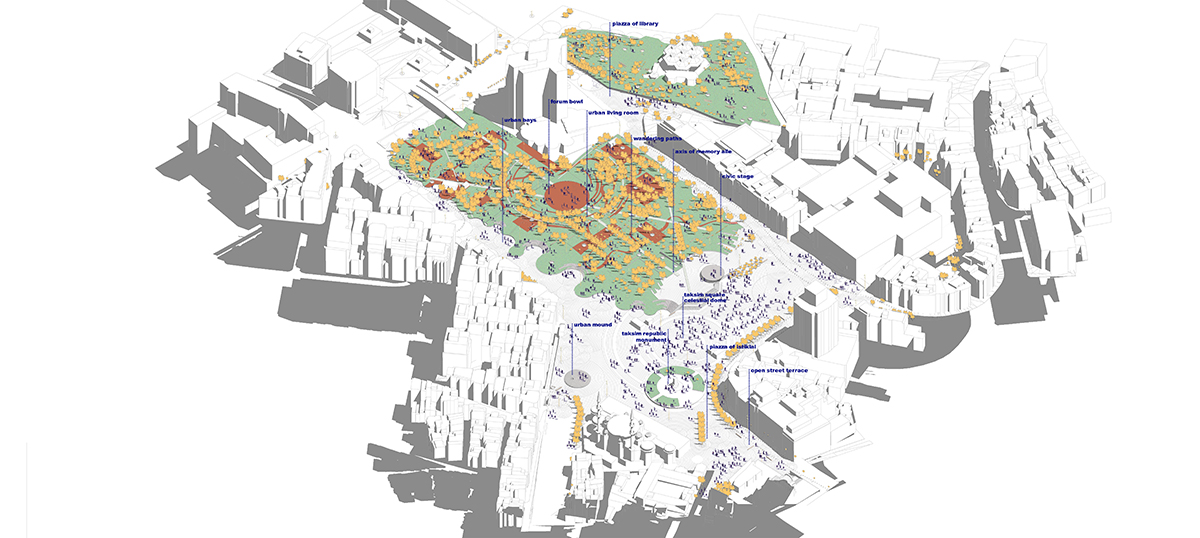
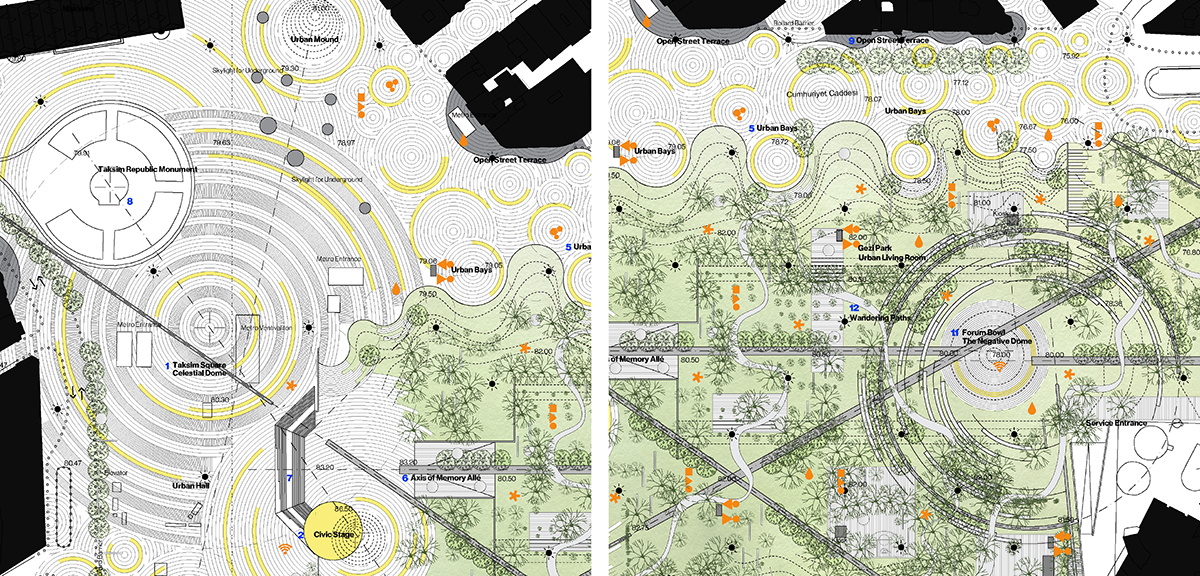
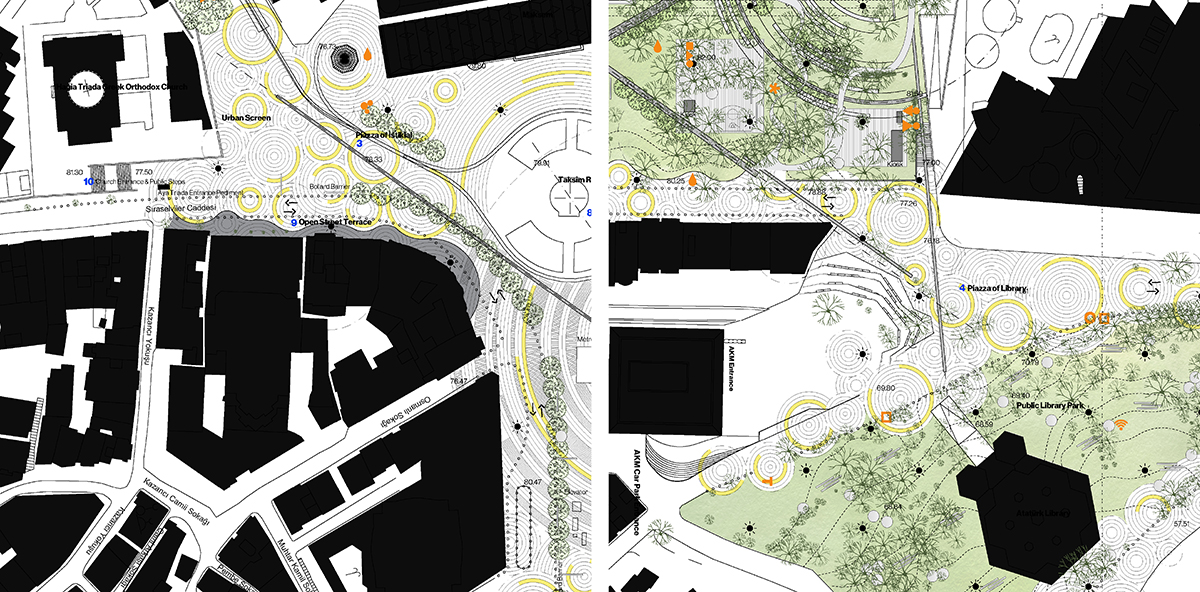
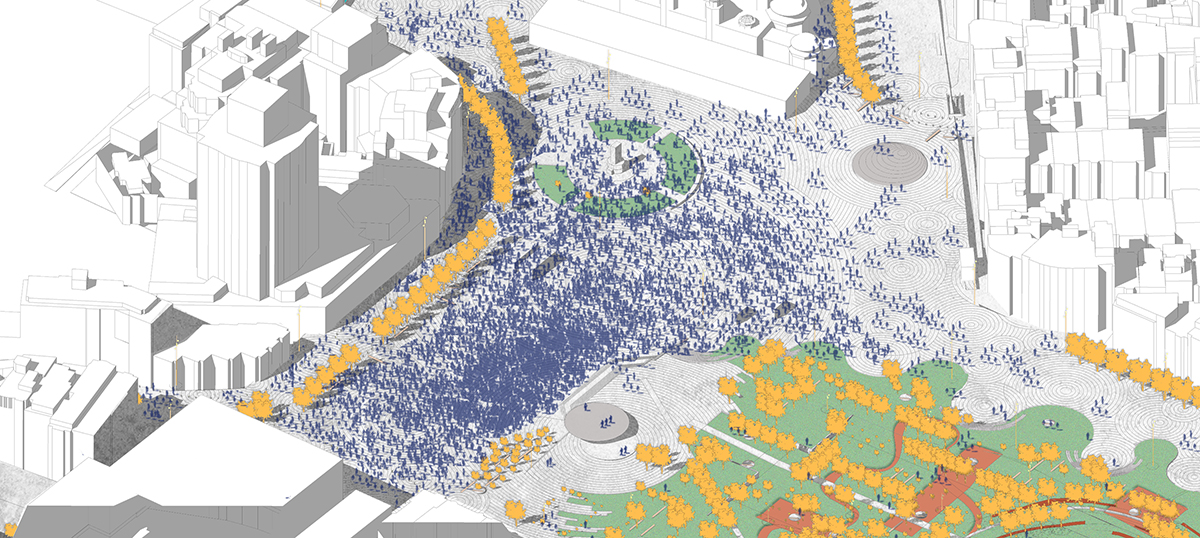
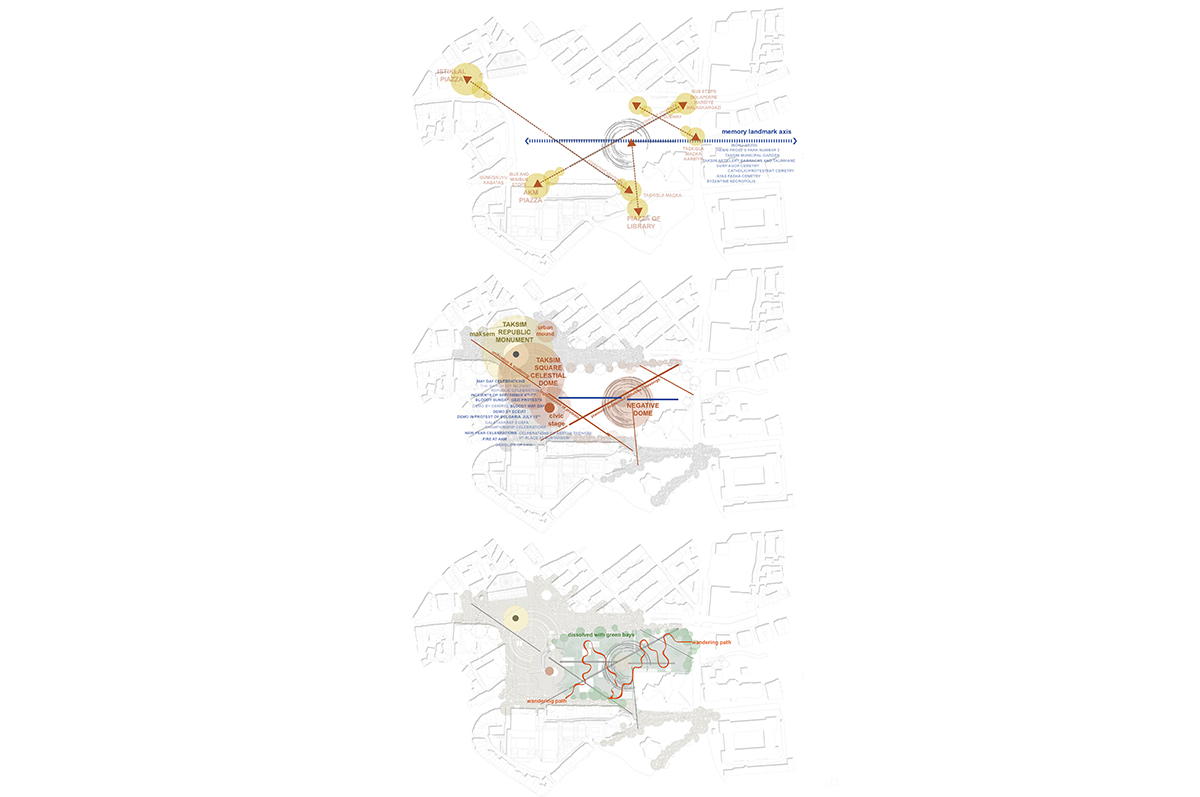
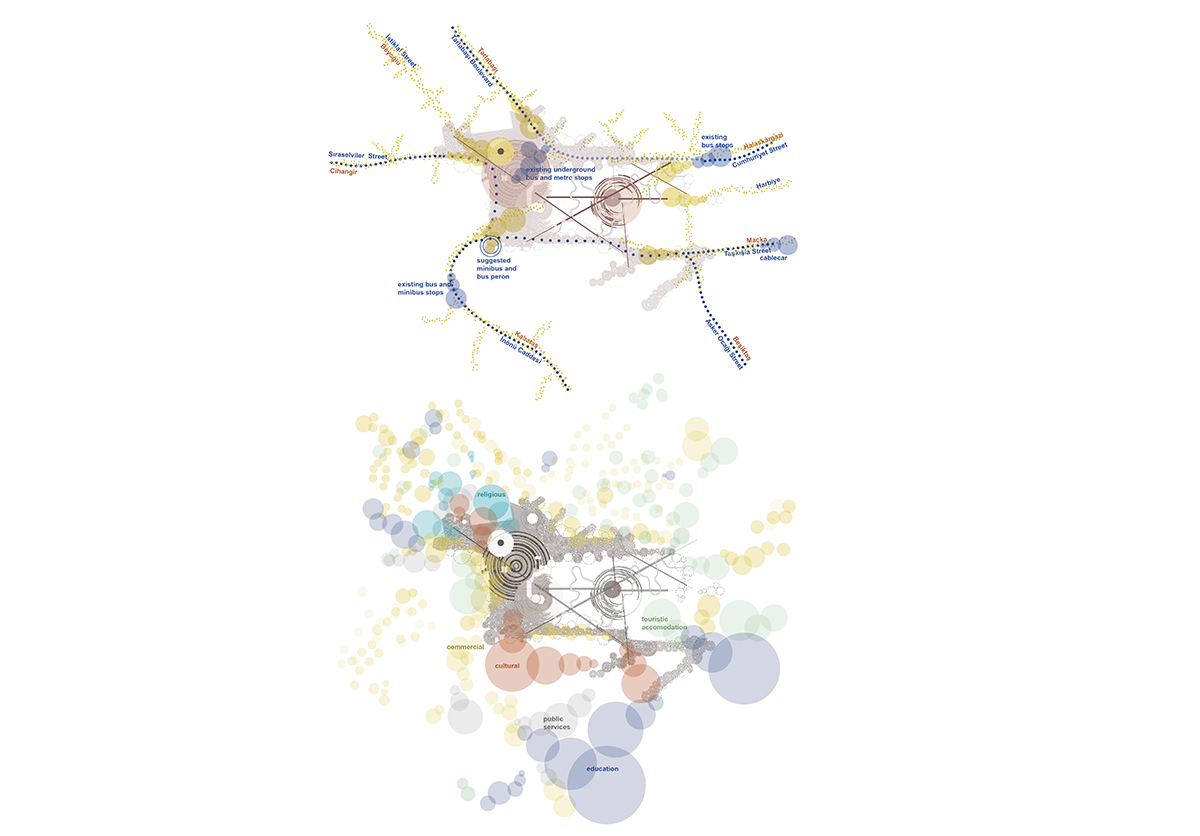
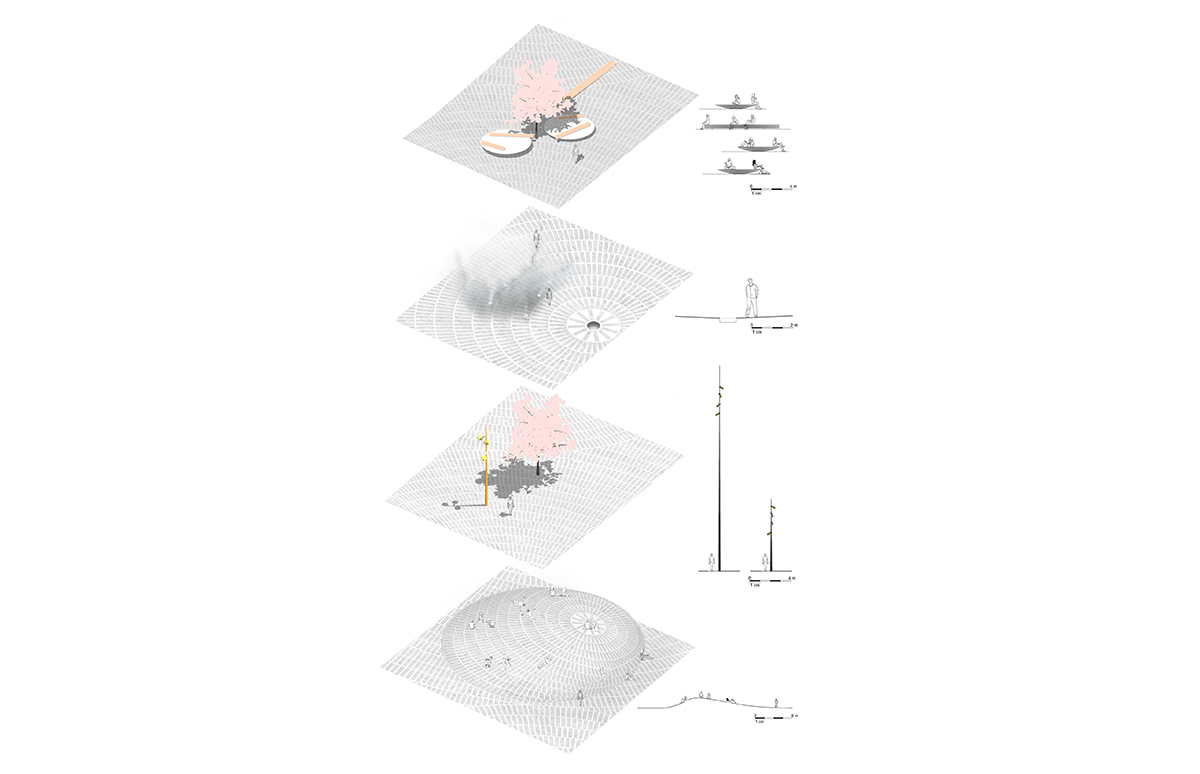
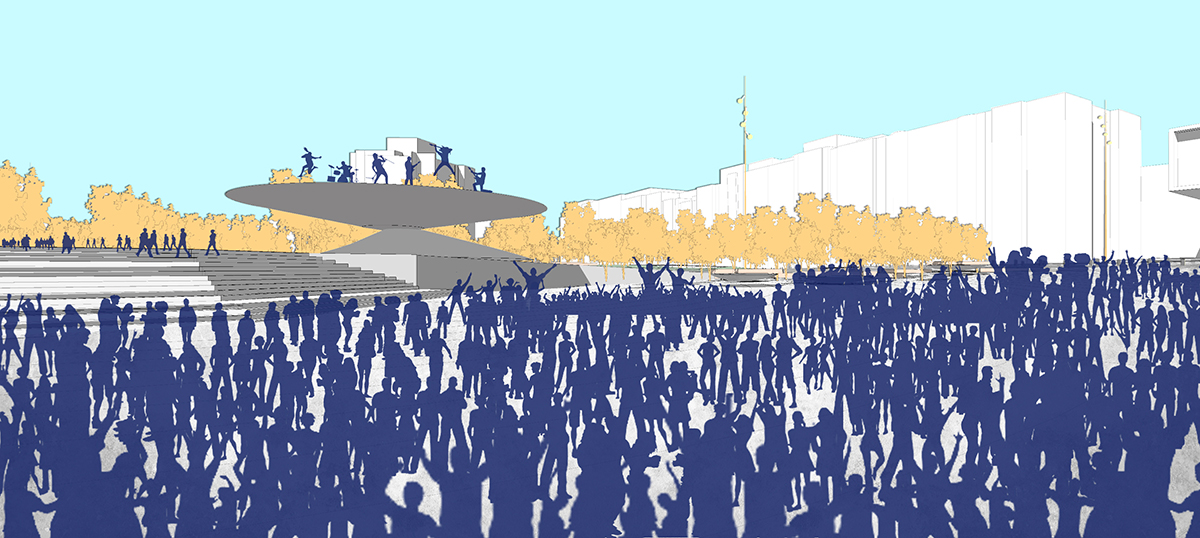
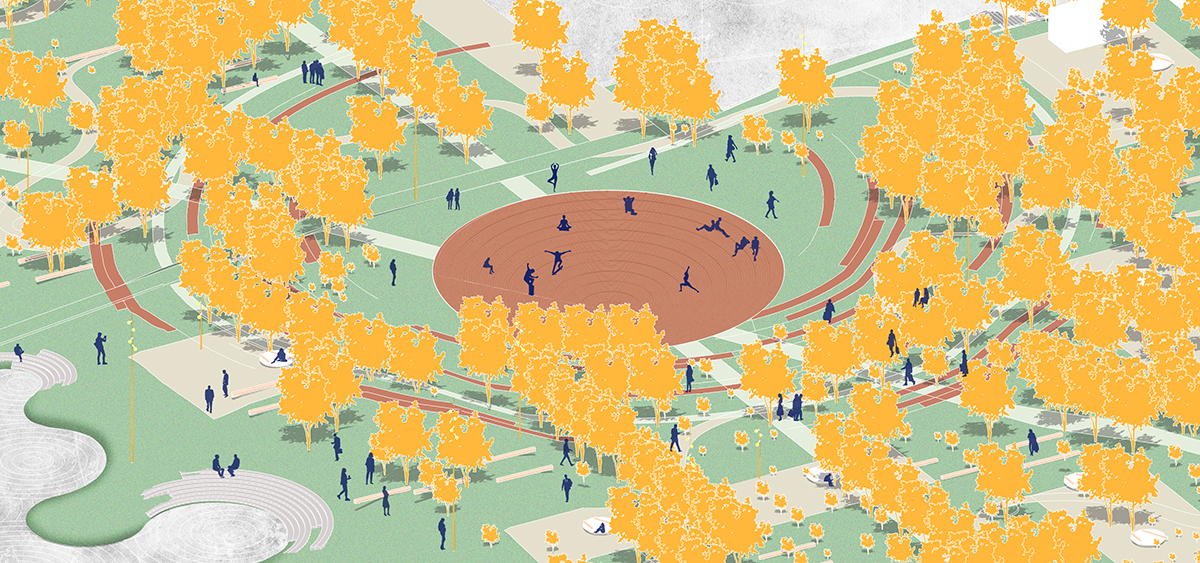
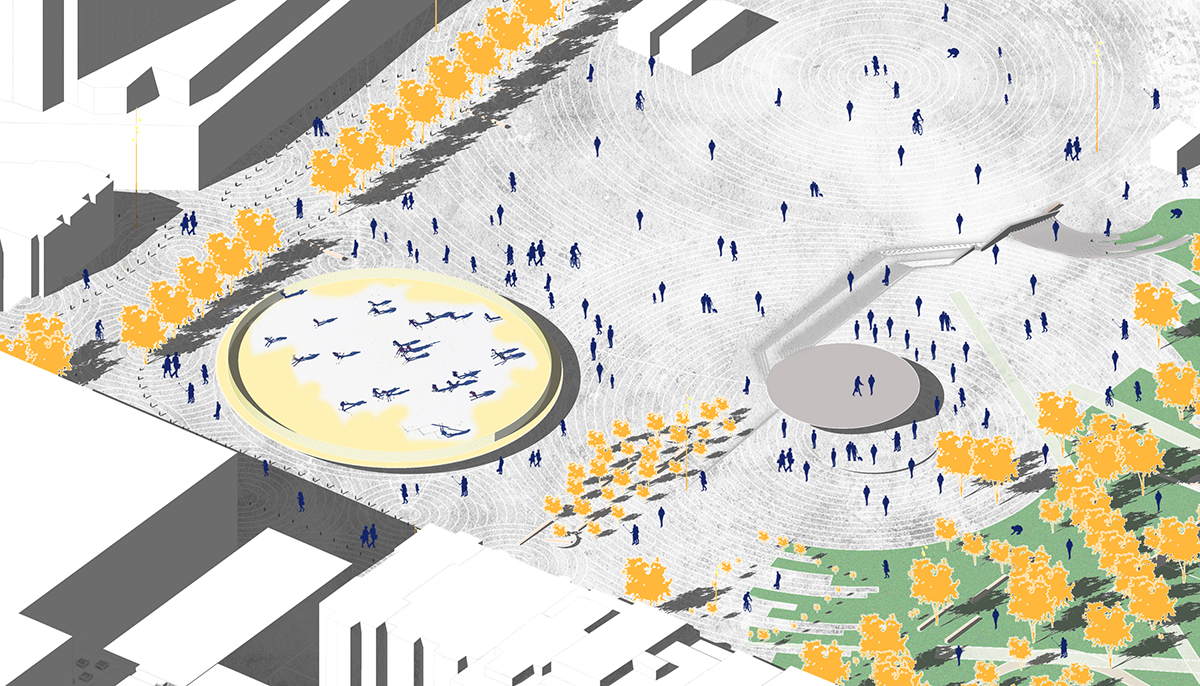
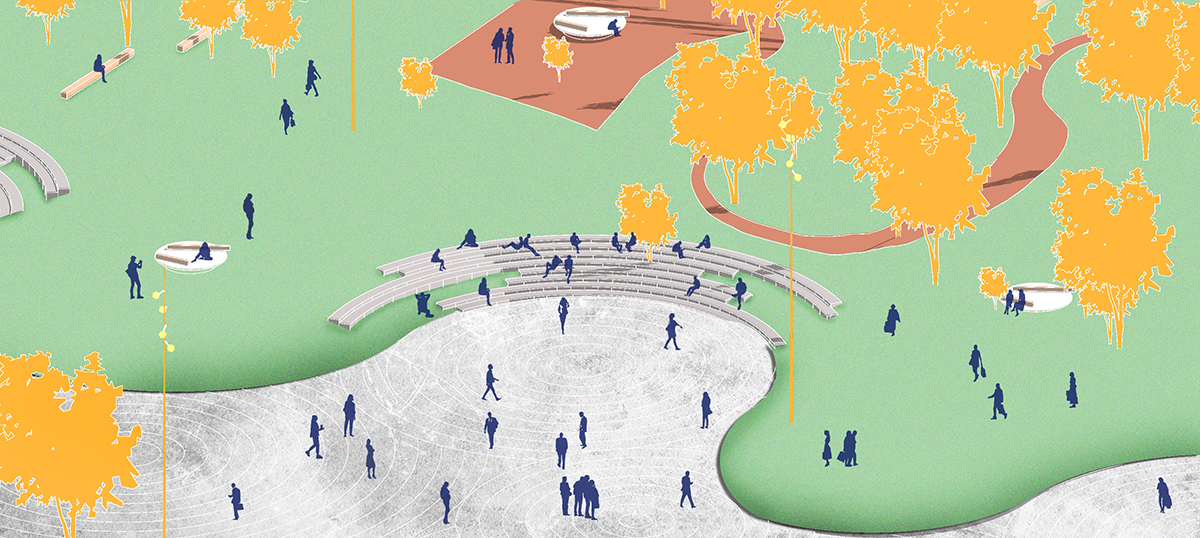
DESIGN
- Semra Uygur
- Özcan Uygur
- Deniz Uygur
COMPETITION REPORT:
The entirety of the built environment exists in a state of flux and adaptation dependent on the
mutual relation between society and its spatial outcomes. Accordingly public space or in better
words “urban common” should eventually alter and mold itself. While revitalization is a must, in the
case of Taksim Square and Gezi Park , there is also an apparent vagueness of spatial identity to be
elucidated.
"Only where things can be seen by many in a variety of aspects without changing their identity, so
that those who are gathered around them know they see sameness in utter diversity, can worldly
reality truly and reliably appear."
- Hannah Ardent
“Public space is a place in which there is a momentary condition of equality”
- Saskia Sassen
CHOREOGRAPHY OF DOMES, ISTANBUL
Istanbul has a unique landscape and geography with its own built environment which is actually
orchestrated layer on layer through a long history. Considering the fact that different societies
have long lived on this geography the city has a quality of cultural heritage not only for Turkish
Republic but also for many other nations. Right after the image of Bosporus the second particular
image of the city is sequences of domes. Byzantine domes, Greek church domes, Turkish Bath domes,
Mosque domes, Grand Bazaar domes... “domes on domes arise”. Only by ignoring the very recent mass
construction silhouettes, choreography of domes is still the most recognizable human made picture of
this historic city. Considering the elemental beauty and phenomenon of dome , inevitably this
influential geometry reveals its own social and aesthetic potentials. Dome with its embracing form
and being, could connect people under one roof and scatter them around as parts of the one coherent
whole, just as happened in the history of Istanbul. The form of uniting and scattering... Since dome
is purely omnidirectional, a dome or even a cluster of domes has a huge potential to connect various
parameters of space as a one coherent whole under its neutral form.
URBAN CARPET / WHIRLING PATTERN
The proposed design is materialized by two-dimensional projection of dome form, and dome transforms
into a sphere and consequently series of spheres. Taksim square and its periphery are so defined by
a pure geometric form which properly multiplied and dilated. Various sized spheres and their various
compositions defines a series of thematic areas that can freely expand or contract according to the
needs of users. The pattern of spheres eventually generates an urban carpet. In order to perceive
the space as one coherent place, the urban carpet is expanded across the roads around. By so doing
not only the square itself but also the peripheral zones are delineated , and even these peripheral
zones can be fully used for larger events and occasions. The whirling pattern of the carpet
intensifies the urban continuum. The urban carpet is remarkable by the solidity of its natural stone
surface, which is composed by mainly Marmara marble.
TAKSIM SQUARE / THE CELESTIAL DOME
With the interpretation of domes, Taksim square, as the urban hall and the main gathering zone of
Istanbul, turns metaphorically into a celestial dome which is concentric to urban common in this
case. Public square so becomes the proverbial center stage upon which collective action is both
possible and symbolically meaningful. The celestial dome differentiates from the other spherical
patterns of the urban carpet because of its capacity, public meaning and social gravitational force.
For the material here Marmara marble and Bergama granite is used together in order to mimic a
whirling force of the literal center of this urban void. For night usage recessed effect lighting is
suggested on this target zone to represent the image of celestial dome and enrich the atmosphere.
The project here balances between the concrete and the enigmatic.
URBAN BAYS
Taksim Gezi Park(Inonu Gezisi), a public garden of some forty thousand square meters adjoining
Taksim Square in the Beyoğlu district. The park was designed by the French urban planner Henri
Prost, who was commissioned by President Mustafa Kemal Atatürk to carry out ambitious plans for
modernizing the city in the 1940s and 1950s. Ottoman-style Artillery Barracks, which was built atop
a graveyard was demolished in 1943 in order to extend the free surface of Taksim Square. Thus, the
site was once necropolis then a military zone and finally an urban garden which was originally
connected to ParkNo2. However, considering the current situation, the park is a way too introverted,
connecting actually nowhere by its own circulation routes, lacking the feeling of safety and
comfort, and moreover the level difference between the square and park appears to be as an obstacle
which prevents the fluidity among square, park and streets around. The proposed project aimed to
dissolve this level difference and offer a smooth porosity and fluidity. The reformation of park is
planned carefully to minimize disruption to the sub-surface, and even conserving the height
difference in the park which is the trace of courtyard of Artillery barrack. Sinuous shaped slight
interventions on the morphology of edges generates so called urban bays which offers autonomous and
comparatively small sized public spaces with irregular amphitheater formations and green texture
leaks into the Cumhuriyet Caddesi. Urban bays do not try to establish rigid configurations but
leaves room for improvisation.
CIVIC STAGE
As an aesthetic sculpture-like object, a Civic Stage is positioned literally on the junction point
of park and square. Civic Stage aims to reunite the park and the square while legitimating the
freedom of speech and any kind of performing with its actual existence. With its disk-like form,
Civic Stage is dag asymmetrically into a mound-like structure in which people can freely climb up or
a preparation room could be organized for performing arts, rallies and etc. . Thanks to the
omnidirectionality of its form being a circle, the Civic Stage can gather both the park and the
square with its audience around for various uses. It can also be adopted as a panorama terrace or
even more improvisational usage, thus an elevated stage image which is conventionally used for
autocratic rallies becomes a part of daily life by being casually used by citizens. The program of
regular concerts and shows gives a new lease of life. This stage object should also be considered as
a manifestation by offering and normalizing gatherings. In one way or another this participatory
Civic Stage portrays the physicality of citizenship as a form of insurgent urbanism. It is a
modernized equivalent of “Rostra” but it is totally “civic” and used also by random citizens in this
case.
SET OF SQUARES / INTERCONNECTION OF ATMOSPHERES
The main design principle is the realization of non- hierarchical environment in which users can
become protagonists in the definition of space itself. What really matters is the ability to
multiply relations among citizens and place. Thus, there is actually no longer a simple square and
one specific atmosphere, but a set of “piazzas” and various atmospheres interconnected with each
other and capable of triggering relationships. By so doing, all kinds of things can be going on at
once in its different corners. The principle is enforcing the quality of public space by simply
enforcing Taksim Square and Gezi Park’s presence and current spatial potentials. Thus, with the
proposed design on the south side the walls around Atatürk Library is removed and private garden of
library is now a public Library Park offering a new cultural atmosphere. At the same part of the
site, the back entrance of AKM gets connected to Gezi Park and Atatürk Library, thus now this zone
is called Piazza of Library. For similar reasons on the west part of the site, the disqualified
relatively small buildings in front of Aya Triada Church are removed. Accordingly, the hidden image
of Church is now more accessible, and with the Mosque right across the street now there is an
atmosphere with cultural variability is offered. This zone is called now “Piazza of Istiklal”.
Besides, by this reorganization, public stairs and an urban screen are proposed in order to enrich
the variable possible usages.
MEMORY AXIS AND CROSSROADS
Gezi Park is reorganized with its atmosphere and life inside, but all of the trees and except
smoothing the edges, the particular morphology are conserved. The purpose is adopted as
reconstructing the foundations of its identity. Considering the collective memory of the main axis
of original Gezi Park (Inonu Gezisi) design by Henri Prost, the axis is revitalized as a trace in
the park, Memory Axis Alle. One way or another this trace brings people to Taksim Square . Two
dead-straight crossroads are found in the park giving shortcut connections from “Piazza of Istiklal”
to “Piazza of Library” and from AKM to east side of Cumhuriyet Caddesi. By so doing park appears to
be on daily routes of main circulation directions.
WANDERING PATHS
Accepting the park as an urban living room, orchestrating the life in Gezi Park ends up with
randomly positioned urban elements with a loose configuration strategy. Some play-scape elements for
adults and kids, basketball pots, public art pieces, urban furniture, even lighting elements,
drinking fountains, wc cabins and kiosks distribute facilities throughout the park. Thus a lazy
wandering path is positioned which allows visitors to explore Gezi Park in a leisurely way. On the
contrary of current situation , green texture covers up the whole park domain and some brick floored
open rooms are just scattered in the green texture of park.
NEGATIVE DOME / THE FORUM BOWL
Gezi park’s public domain is tried to be designed in a way to exemplify how a legible public domain
framework can unite a site. Sticking to the main concept of uniting power of domes, as the core of
Gezi Park , a negative dome is positioned where a circular texture has already been found for long
times even since the Artillery Barracks. In order to stimulate this zone, The negative dome is
designed as a “Forum Bowl” where people could get organized for forums, workshops, discussions or
even for some occasional events. In order to expand or contract the orbit of Forum Bowl when it is
needed, brick patterns are loosely configurated around. The Forum Bowl could also be considered as
an outcome of Gezi Park protests of 2013.
SERENDIPITY / SCATTERED URBAN ELEMENTS
Serendipity could be considered as a sub-concept of the proposed project because of the casual
composition of facilities. The aim is to vitalize contemporary spatial usage opportunities into a
historic context.
Several public art pieces are randomly positioned in Gezi Park and so visitors would explore them
just by wandering around. Thus park turns also into an open air exhibition. Urban Furniture is
scattered in different zones and atmospheres with an irregular order, and thus a place of urban
comfort is offered in all different corners of the site. The same composition strategy is valid also
for the playscape elements in and around the site. Basically playscape elements are accepted not
only for children but also for adults. Thus these elements should now be designed in an
unconventional way in order to engage people in all ages. Moreover, adopting the fact that kids are
just short human beings, facilities and playscapes are evenly positioned for them throughout the
site to encourage kids getting participate in the society from the early ages.
In the square some water features could be found in order to attract people when there is nothing
happening and give a cool breeze in hot summer days. These water features are imaged to give a more
atmospheric mood instead of just being common fountains. They are more like clouds of cold water
vapour, just as an ethereal art piece.
LIGHTING STRATEGY
In order to stimulate the dynamism of Taksim Square and the peripheral site together in the dark
hours of evening and night, a programmable and adaptive lighting system is proposed. The vertical
light elements react to the movements of pedestrians and interaction on the square. Thus a dynamic
mood and atmosphere transformation is offered. Additionally on “the celestial dome “ a recessed
floor lighting system is proposed.
PROPOSED PLANTATION
While conserving all trees in Gezi Park, with the aim of improving the climatic conditions new tree
plantation is offered in order to have thicker vegetation. To highlight the crossroads and The
Memory Axis Allé, on one side of these dead-straight paths series of trees are proposed. Near urban
bays trees are to be planted in order to offer shady comfort zones. Additionally on the east part of
the site right near the Taksim Square, a series of tree plantation is offered again. For trees
mostly endemics of Istanbul are preferred:
Cedars (are especially for the sides of crossroads in the park to keep the green texture even in
winter season)
Weeping Wilow (Salix babylonica) is more for sides of Urban bays because of their large shades.
Mimosa (Acacia Dealbata)
Redbud tree (Cercis canadensis)
Wisteria
PERIPHERAL BUILDINGS / OPEN STREET TERRACE
Peripheral buildings should have a lively usage in order to generate a safer and active atmosphere
of Taksim square. Thus for the ground floors, the facilities should be reconsidered . Cafes, bars,
mini-venues, book stores, restaurants could be promoted by the Municipality. With open street
terraces of these facilities the mood of the Taksim Square would enrich the spatial qualities such
as accessibility, comfort and sociability.
- Location
- Competition
- Client
- İstanbul, Turkey
- 2020
- İstanbul Metropolitan Municipality


